
Acradenia euodiiformis, commonly known as yellow satinheart or bonewood, is a species of tree that is endemic to eastern Australia. It has mostly trifoliate leaves, the leaflets narrow elliptic to lance-shaped, with prominent oil glands, and panicles of white flowers. It grows in and near rainforest.

Acronychia octandra, commonly known as doughwood, silver birch or soapwood, is a species of rainforest tree that is endemic to eastern coastal areas of Australia. It has mostly trifoliate leaves with elliptic to egg-shaped leaflets, greenish-white flowers arranged in groups in leaf axils and fleshy fruit of four carpels fused at the base.

Acronychia pubescens, commonly known as hairy acronychia or hairy aspen, is a species of tall shrub or small tree that is endemic to eastern Australia. It usually has trifoliate leaves, rarely simple leaves, groups of whitish flowers in leaf axil|s and creamy to yellowish, elliptical to spherical fruit.
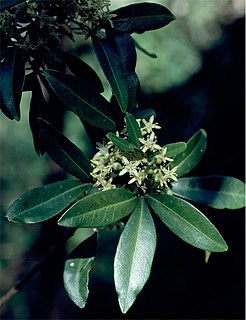
Acronychia suberosa , commonly known as corky acronychia, is a species of small to medium-sized rainforest tree that is endemic to eastern Australia. It has mostly trifoliate leaves with ellitic to egg-shaped leaflets with the narrower end towards the base, small groups of cream-coloured flowers and elliptical to spherical, creamy yellow to whitish fruit.

Zanthoxylum ovalifolium, commonly known as thorny yellowwood, oval-leaf yellow wood or little yellowwood, is a species of flowering plant in the family Rutaceae. It is a shrub or tree usually with trifoliate leaves, white, male and female flowers arranged in panicles in leaf axils or on the ends of branchlets and red, purple or brown follicles.
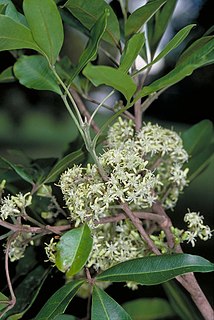
Acronychia acronychioides, commonly known as white aspen, is a species of small to medium-sized rainforest tree that is endemic to north-eastern Queensland. It has trifoliate leaves with elliptic to egg-shaped leaves on stems that are more or less cylindrical, creamy yellow flowers in large groups in leaf axils and fleshy, pear-shaped or spherical fruit.
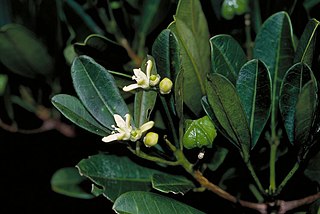
Acronychia chooreechillum, commonly known as mountain aspen, is a species of shrub or small rainforest tree that is endemic to north-eastern Queensland. It has mostly trifoliate leaves with elliptic to egg-shaped leaflets on stems that are more or less cylindrical, flowers in small groups in leaf axils and fleshy, egg-shaped or elliptical fruit.
Acronychia eungellensis, commonly known as Eungella aspen, is a species of small rainforest tree that is endemic to a restricted area in east-central Queensland. It has simple, elliptic leaves on cylindrical stems, flowers in small groups in leaf axils, and fleshy fruit that is elliptic to egg-shaped in outline.
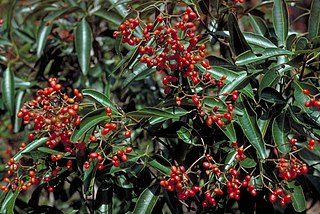
Dinosperma is a genus of plant containing the single species Dinosperma erythrococcum, commonly known as tingletongue, clubwood or nutmeg, and is endemic to north-eastern Australia. It is a tree usually with trifoliate leaves arranged in opposite pairs, the leaflets lance-shaped to oblong, and panicles of small white flowers, later bright orange to red, slightly fleshy follicles containing shiny, bluish black seeds.
Medicosma elliptica, commonly known as Bulburin medicosma, is a species of shrub or small tree in the family Rutaceae and is endemic to a restricted area of Queensland. It has elliptical leaves and white flowers borne singly or in small groups in leaf axils.

Medicosma fareana, commonly known as white aspen, is a species of rainforest small tree in the family Rutaceae and is endemic to north Queensland. It has elliptical leaves and white or cream-coloured flowers borne singly or in small groups in leaf axils.
Medicosma forsteri is a species of small tree in the family Rutaceae and is endemic to a restricted area of Queensland. It has elliptical leaves and cream-coloured flowers borne singly or in small groups in leaf axils.
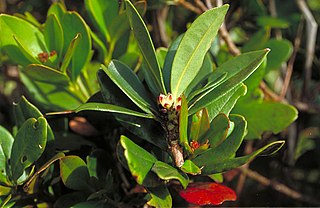
Medicosma glandulosa is a species of shrub or small tree in the family Rutaceae and is endemic to far north Queensland. It has elliptical to egg-shaped leaves and flowers that are white with red tips or cream-coloured, borne singly or in small groups in leaf axils.
Medicosma mulgraveana is a species of small tree in the family Rutaceae and is endemic to a restricted area of far north Queensland. It has mostly trifoliate leaves with elliptical to egg-shaped leaflets and white flowers borne in small groups in leaf axils.
Medicosma obovata is a species of shrub or small tree in the family Rutaceae and is endemic to a restricted area of far north Queensland. It has simple egg-shaped leaves with the narrower end towards the base and white flowers borne singly or in small groups in leaf axils.

Medicosma sessiliflora is a species of shrub or small tree in the family Rutaceae and is endemic to far north Queensland. It has simple elliptical to egg-shaped leaves with the narrower end towards the base and cream-coloured flowers borne singly or in small groups in leaf axils.
Melicope affinis is a species of shrub or tree in the family Rutaceae and is endemic to Queensland. It has trifoliate leaves and small greenish white flowers borne in panicles in leaf axils.

Melicope broadbentiana, commonly known as false euodia, is a species of shrub or tree in the family Rutaceae and is endemic to Queensland. It has simple leaves, trifoliate leaves or both, and small white flowers borne in short panicles in leaf axils.
Melicope fellii is a species of tree in the family Rutaceae and is endemic to Queensland. It has trifoliate leaves and pink flowers borne in short panicles in leaf axils.

Melicope vitiflora, commonly known as northern evodia, fishpoison wood, leatherjacket or leatherwood, is a species of shrub or small tree in the family Rutaceae and is native to north-eastern Australia and New Guinea. It has trifoliate leaves and green to white or cream-coloured flowers borne in panicles in leaf axils.












